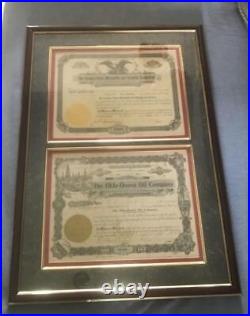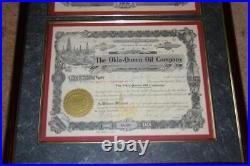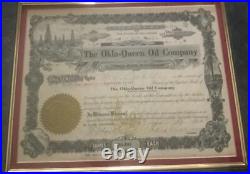






1959 FUNDAMENTALS OF OIL & GAS PRODUCTION PETROLEUM ENGINEER DALLAS TEXAS TX VTG. OLD STOCK CERTIFICATE FARMER UNION MERCANTILE KANSAS OKLA QUEEN OIL OKLAHOMA VTG. We are not experts. We welcome any comments, questions, or concerns. WE ARE TARGETING A GLOBAL MARKET PLACE. Thanks in advance for your patronage. Please Be sure to add WDG to your. NOW FOR YOUR VIEWING PLEASURE. (2) TWO STOCK CERTIFICATES. FRAMED, MATTED, UNDER GLASS. SCRIPOPHILY BY CRANE COMPANY TOPEKA. THE OKLA-QUEEN OIL COMPANY. INCORPORATED UNDER THE LAWS OF THE STATEOF. LITTLE TO NO COMPANY HISTORY HAS BEEN FOUND. HOWEVER THIS COMPANY WAS LATER ABSORBED BY STANDARD OIL. FRAME MEASURES ABOUT 15.5″ X 23″. SIGNATURES ARE OUR BEST TRANSLATION. AND MAY NOT BE 100% ACCURATE. Petroleum, from early 15c. “Petroleum, rock oil” mid-14c. In Anglo-French, from Medieval Latin petroleum, from Latin petra rock(see petrous) + Latin: oleum oil see oil n. Is a naturally occurring, yellow-to-black liquid found in geologic formations beneath the Earth’s surface, which is commonly refined into various types of fuels. It consists of hydrocarbons of various molecular weights and other liquid organic compounds. The name petroleum covers both naturally occurring unprocessed crude oil and petroleum products that are made up of refined crude oil. A fossil fuel, petroleum is formed when large quantities of dead organisms, usually zooplankton and algae, are buried underneath sedimentary rock and subjected to intense heat and pressure. Petroleum is recovered mostly through oil drilling (natural petroleum springs are rare). This comes after the studies of structural geology (at the reservoir scale), sedimentary basin analysis, reservoir characterization (mainly in terms of the porosity and permeability of geologic reservoir structures). It is refined and separated, most easily by distillation, into a large number of consumer products, from gasoline (petrol) and kerosene to asphalt and chemical reagents used to make plastics and pharmaceuticals. Petroleum is used in manufacturing a wide variety of materials, and it is estimated that the world consumes about 90 million barrels each day. The use of fossil fuels, such as petroleum, has a negative impact on Earth’s biosphere, releasing pollutants and greenhouse gases into the air and damaging ecosystems through events such as oil spills. Concern over the depletion of the earth’s finite reserves of oil, and the effect this would have on a society dependent on it, is a concept known as peak oil. Etymology The word petroleum comes from Greek: p? A (petra) for rocks and Greek:?? The term was found (in the spelling “petraoleum”) in 10th-century Old English sources. It was used in the treatise De Natura Fossilium, published in 1546 by the German mineralogist Georg Bauer, also known as Georgius Agricola. In the 19th century, the term petroleum was frequently used to refer to mineral oils produced by distillation from mined organic solids such as cannel coal (and later oil shale), and refined oils produced from them; in the United Kingdom, storage (and later transport) of these oils were regulated by a series of Petroleum Acts, from the Petroleum Act 1862 onwards. History Early history Petroleum, in one form or another, has been used since ancient times, and is now important across society, including in economy, politics and technology. The rise in importance was due to the invention of the internal combustion engine, the rise in commercial aviation, and the importance of petroleum to industrial organic chemistry, particularly the synthesis of plastics, fertilizers, solvents, adhesives and pesticides. More than 4000 years ago, according to Herodotus and Diodorus Siculus, asphalt was used in the construction of the walls and towers of Babylon; there were oil pits near Ardericca (near Babylon), and a pitch spring on Zacynthus. Great quantities of it were found on the banks of the river Issus, one of the tributaries of the Euphrates. Ancient Persian tablets indicate the medicinal and lighting uses of petroleum in the upper levels of their society. By 347 AD, oil was produced from bamboo-drilled wells in China. Early British explorers to Myanmar documented a flourishing oil extraction industry based in Yenangyaung, that in 1795 had hundreds of hand-dug wells under production. The mythological origins of the oil fields at Yenangyaung, and its hereditary monopoly control by 24 families, indicate very ancient origins. Modern history In 1847, the process to distill kerosene from petroleum was invented by James Young. He noticed a natural petroleum seepage in the Riddings colliery at Alfreton, Derbyshire from which he distilled a light thin oil suitable for use as lamp oil, at the same time obtaining a thicker oil suitable for lubricating machinery. In 1848 Young set up a small business refining the crude oil. Young eventually succeeded, by distilling cannel coal at a low heat, in creating a fluid resembling petroleum, which when treated in the same way as the seep oil gave similar products. Young found that by slow distillation he could obtain a number of useful liquids from it, one of which he named “paraffine oil” because at low temperatures it congealed into a substance resembling paraffin wax. The production of these oils and solid paraffin wax from coal formed the subject of his patent dated 17 October 1850. In 1850 Young & Meldrum and Edward William Binney entered into partnership under the title of E. At Bathgate in West Lothian and E. Another early refinery was built by Ignacy Lukasiewicz, providing a cheaper alternative to whale oil. The demand for petroleum as a fuel for lighting in North America and around the world quickly grew. [16] Edwin Drake’s 1859 well near Titusville, Pennsylvania, is popularly considered the first modern well. Drake’s well is probably singled out because it was drilled, not dug; because it used a steam engine; because there was a company associated with it; and because it touched off a major boom. However, there was considerable activity before Drake in various parts of the world in the mid-19th century. A group directed by Major Alexeyev of the Bakinskii Corps of Mining Engineers hand-drilled a well in the Baku region in 1848. There were engine-drilled wells in West Virginia in the same year as Drake’s well. An early commercial well was hand dug in Poland in 1853, and another in nearby Romania in 1857. At around the same time the world’s first, small, oil refinery was opened at Jaslo in Poland, with a larger one opened at Ploie? Ti in Romania shortly after. Romania is the first country in the world to have had its annual crude oil output officially recorded in international statistics: 275 tonnes for 1857. The first commercial oil well in Canada became operational in 1858 at Oil Springs, Ontario (then Canada West). Businessman James Miller Williams dug several wells between 1855 and 1858 before discovering a rich reserve of oil four metres below ground. Williams extracted 1.5 million litres of crude oil by 1860, refining much of it into kerosene lamp oil. William’s well became commercially viable a year before Drake’s Pennsylvania operation and could be argued to be the first commercial oil well in North America. The discovery at Oil Springs touched off an oil boom which brought hundreds of speculators and workers to the area. Advances in drilling continued into 1862 when local driller Shaw reached a depth of 62 metres using the spring-pole drilling method. On January 16, 1862, after an explosion of natural gas Canada’s first oil gusher came into production, shooting into the air at a recorded rate of 3,000 barrels per day. By the end of the 19th century the Russian Empire, particularly the Branobel company in Azerbaijan, had taken the lead in production. Access to oil was and still is a major factor in several military conflicts of the twentieth century, including World War II, during which oil facilities were a major strategic asset and were extensively bombed. The German invasion of the Soviet Union included the goal to capture the Baku oilfields, as it would provide much needed oil-supplies for the German military which was suffering from blockades. Oil exploration in North America during the early 20th century later led to the US becoming the leading producer by mid-century. As petroleum production in the US peaked during the 1960s, however, the United States was surpassed by Saudi Arabia and the Soviet Union. Today, about 90 percent of vehicular fuel needs are met by oil. Petroleum also makes up 40 percent of total energy consumption in the United States, but is responsible for only 1 percent of electricity generation. Petroleum’s worth as a portable, dense energy source powering the vast majority of vehicles and as the base of many industrial chemicals makes it one of the world’s most important commodities. Viability of the oil commodity is controlled by several key parameters, number of vehicles in the world competing for fuel, quantity of oil exported to the world market (Export Land Model), Net Energy Gain (economically useful energy provided minus energy consumed), political stability of oil exporting nations and ability to defend oil supply lines. The top three oil producing countries are Russia, Saudi Arabia and the United States. About 80 percent of the world’s readily accessible reserves are located in the Middle East, with 62.5 percent coming from the Arab 5: Saudi Arabia, UAE, Iraq, Qatar and Kuwait. A large portion of the world’s total oil exists as unconventional sources, such as bitumen in Canada and oil shale in Venezuela. While significant volumes of oil are extracted from oil sands, particularly in Canada, logistical and technical hurdles remain, as oil extraction requires large amounts of heat and water, making its net energy content quite low relative to conventional crude oil. Thus, Canada’s oil sands are not expected to provide more than a few million barrels per day in the foreseeable future. Composition In its strictest sense, petroleum includes only crude oil, but in common usage it includes all liquid, gaseous, and solid hydrocarbons. Under surface pressure and temperature conditions, lighter hydrocarbons methane, ethane, propane and butane occur as gases, while pentane and heavier ones are in the form of liquids or solids. However, in an underground oil reservoir the proportions of gas, liquid, and solid depend on subsurface conditions and on the phase diagram of the petroleum mixture. An oil well produces predominantly crude oil, with some natural gas dissolved in it. Because the pressure is lower at the surface than underground, some of the gas will come out of solution and be recovered (or burned) as associated gas or solution gas. A gas well produces predominantly natural gas. However, because the underground temperature and pressure are higher than at the surface, the gas may contain heavier hydrocarbons such as pentane, hexane, and heptane in the gaseous state. At surface conditions these will condense out of the gas to form natural gas condensate, often shortened to condensate. Condensate resembles petrol in appearance and is similar in composition to some volatile light crude oils. Chemistry Petroleum is a mixture of a very large number of different hydrocarbons; the most commonly found molecules are alkanes (paraffins), cycloalkanes (naphthenes), aromatic hydrocarbons, or more complicated chemicals like asphaltenes. Each petroleum variety has a unique mix of molecules, which define its physical and chemical properties, like color and viscosity. The alkanes, also known as paraffins, are saturated hydrocarbons with straight or branched chains which contain only carbon and hydrogen and have the general formula CnH2n+2. They generally have from 5 to 40 carbon atoms per molecule, although trace amounts of shorter or longer molecules may be present in the mixture. Petroleum industry The petroleum industry is involved in the global processes of exploration, extraction, refining, transporting (often with oil tankers and pipelines), and marketing petroleum products. The largest volume products of the industry are fuel oil and petrol. Petroleum is also the raw material for many chemical products, including pharmaceuticals, solvents, fertilizers, pesticides, and plastics. The industry is usually divided into three major components: upstream, midstream and downstream. Midstream operations are usually included in the downstream category. Petroleum is vital to many industries, and is of importance to the maintenance of industrialized civilization itself, and thus is a critical concern to many nations. Oil accounts for a large percentage of the world’s energy consumption, ranging from a low of 32 percent for Europe and Asia, up to a high of 53 percent for the Middle East, South and Central America (44%), Africa (41%), and North America (40%). The world at large consumes 30 billion barrels (4.8 km³) of oil per year, and the top oil consumers largely consist of developed nations. In fact, 24 percent of the oil consumed in 2004 went to the United States alone, though by 2007 this had dropped to 21 percent of world oil consumed. This non-profit trade association was founded in 1907, and is the oldest petroleum trade association in the United States. Agriculture is the cultivation of animals, plants, fungi and other life forms for food, fiber, and other products used to sustain life. Agriculture was the key implement in the rise of sedentary human civilization, whereby farming of domesticated species created food surpluses that nurtured the development of civilization. The study of agriculture is known as agricultural science. Agriculture is also observed in certain species of ant and termite, but generally speaking refers to human activities. The history of agriculture dates back thousands of years, and its development has been driven and defined by greatly different climates, cultures, and technologies. However, all farming generally relies on techniques to expand and maintain the lands suitable for raising domesticated species. For plants, this usually requires some form of irrigation, although there are methods of dryland farming; pastoral herding on rangeland is still the most common means of raising livestock. In the developed world, industrial agriculture based on large-scale monoculture has become the dominant system of modern farming, although there is growing support for sustainable agriculture e. Permaculture or organic agriculture. Modern agronomy, plant breeding, pesticides and fertilizers, and technological improvements have sharply increased yields from cultivation, but at the same time have caused widespread ecological damage and negative human health effects. Selective breeding and modern practices in animal husbandry such as intensive pig farming have similarly increased the output of meat, but have raised concerns about animal cruelty and the health effects of the antibiotics, growth hormones, and other chemicals commonly used in industrial meat production. The major agricultural products can be broadly grouped into foods, fibers, fuels, and raw materials. In the 21st century, plants have been used to grow biofuels, biopharmaceuticals, bioplastics, and pharmaceuticals. Specific foods include cereals, vegetables, fruits, and meat. Fibers include cotton, wool, hemp, silk and flax. Raw materials include lumber and bamboo. Other useful materials are produced by plants, such as resins. Biofuels include methane from biomass, ethanol, and biodiesel. Cut flowers, nursery plants, tropical fish and birds for the pet trade are some of the ornamental products. In 2007, one third of the world’s workers were employed in agriculture. The services sector has overtaken agriculture as the economic sector employing the most people worldwide. Despite the size of its workforce, agricultural production accounts for less than five percent of the gross world product (an aggregate of all gross domestic products). EtymologyThe word agriculture is the English adaptation of Latin agricultura, from ager, “a field”, and cultura, “cultivation” in the strict sense of “tillage of the soil”. Thus, a literal reading of the word yields “tillage of a field / of fields”. Agriculture has played a key role in the development of human civilization. Until the Industrial Revolution, the vast majority of the human population labored in agriculture. In subsistence agriculture cropping decisions are made with an eye to what the family needs for food, and to make clothing, and not the world marketplace. Development of agricultural techniques has steadily increased agricultural productivity, and the widespread diffusion of these techniques during a time period is often called an agricultural revolution. A remarkable shift in agricultural practices has occurred over the past century in response to new technologies, and the development of world markets. This also led to technological improvements in agricultural techniques, such as the Haber-Bosch method for synthesizing ammonium nitrate which made the traditional practice of recycling nutrients with crop rotation and animal manure less necessary. Agricultural practices such as irrigation, crop rotation, fertilizers, and pesticides were developed long ago, but have made great strides in the past century. The history of agriculture has played a major role in human history, as agricultural progress has been a crucial factor in worldwide socio-economic change. Division of labor in agricultural societies made commonplace specializations rarely seen in hunter-gatherer cultures. So, too, are arts such as epic literature and monumental architecture, as well as codified legal systems. When farmers became capable of producing food beyond the needs of their own families, others in their society were freed to devote themselves to projects other than food acquisition. Historians and anthropologists have long argued that the development of agriculture made civilization possible. The total world population probably never exceeded 15 million inhabitants before the invention of agriculture. (THIS PICTURE FOR DISPLAY ONLY). Please leave feedback when you have received the item and are satisfied. Please respond when you have received the item. Our goal is for 5-star service. We want you to be a satisfied, return customer. Please express any concerns or questions. More pictures are available upon request. Please Check out our other items. WE like the curious and odd. Get images that make Supersized seem small. Showcase your items with Auctiva’s. This item is in the category “Coins & Paper Money\Stocks & Bonds, Scripophily\Other Scripophily”. The seller is “cbenhob” and is located in this country: US. This item can be shipped worldwide.
- Circulated/Uncirculated: Circulated
- Country/Region of Manufacture: United States
- Type: Stock

